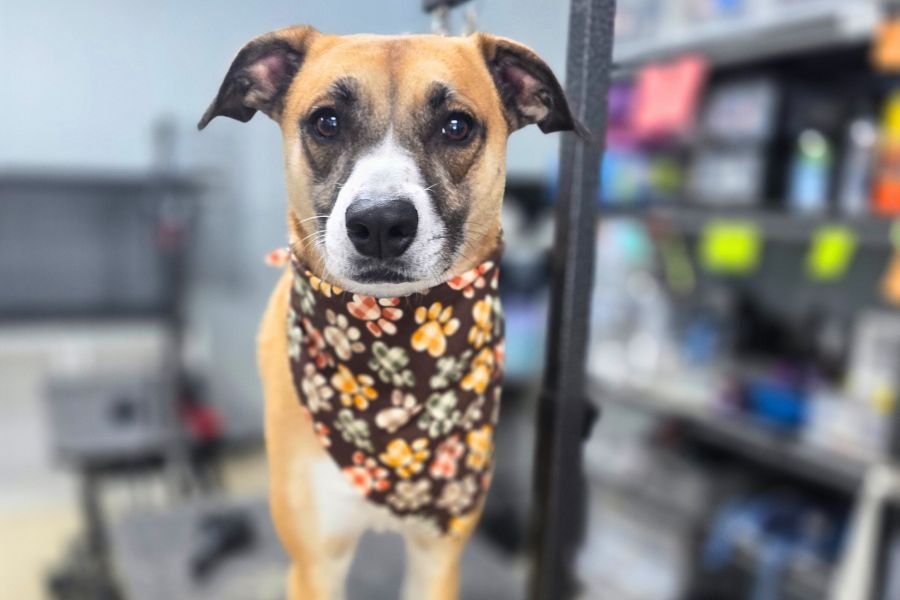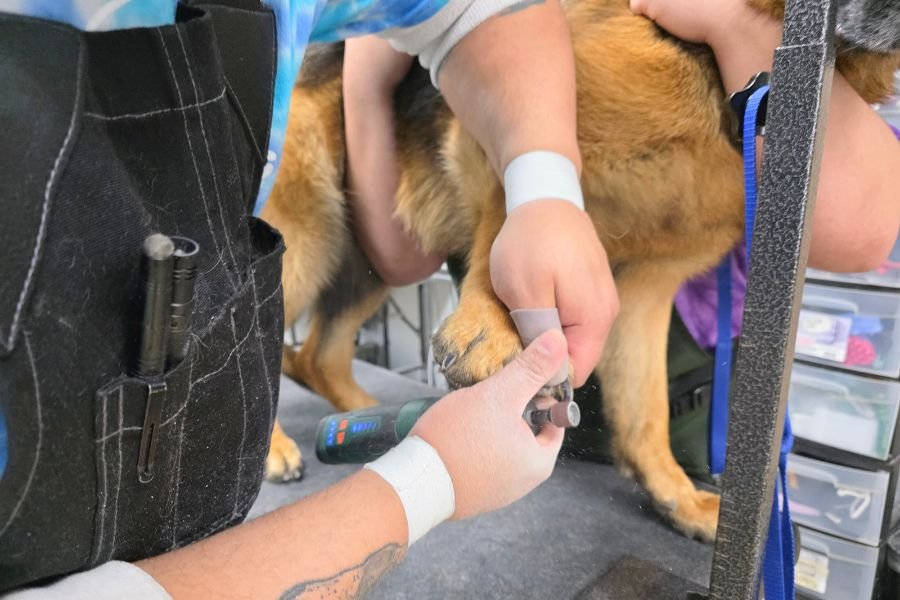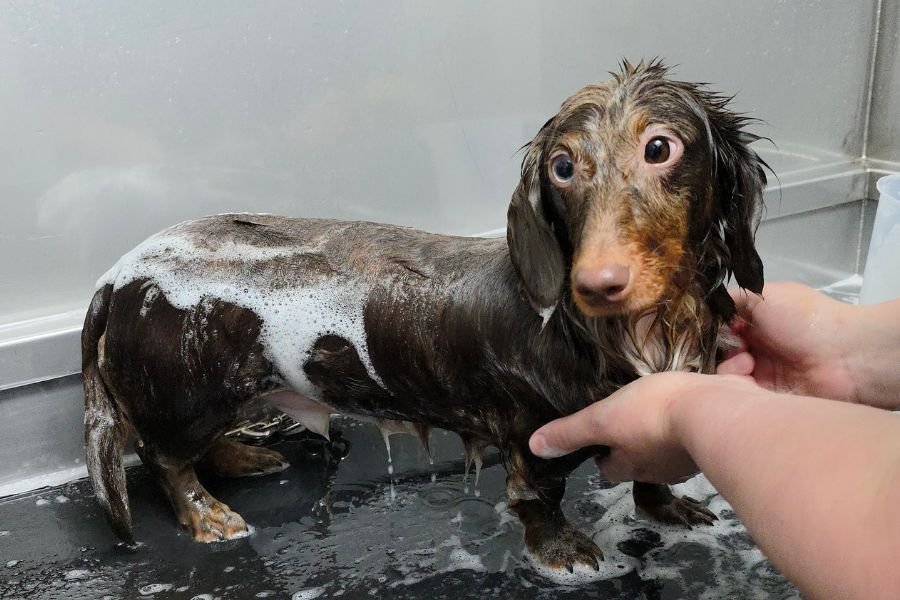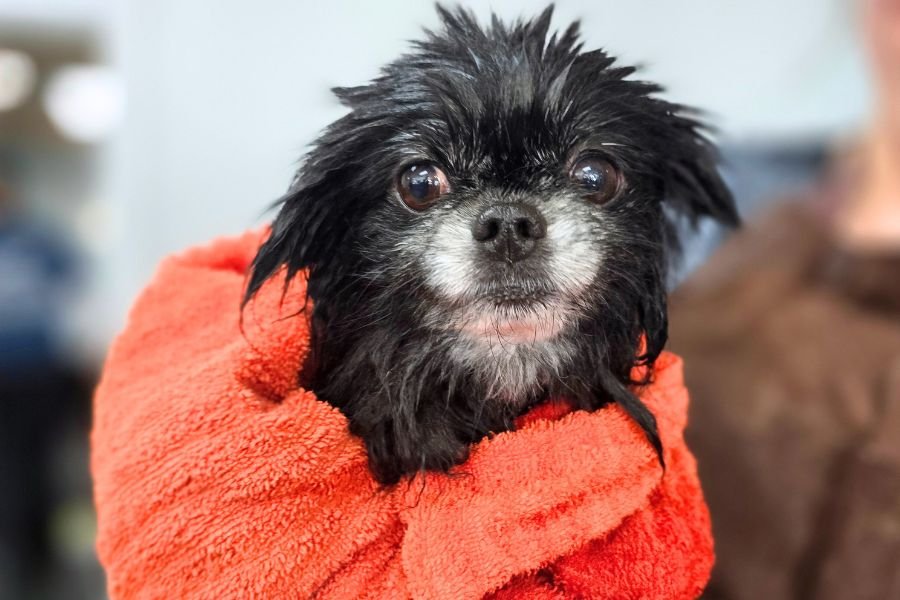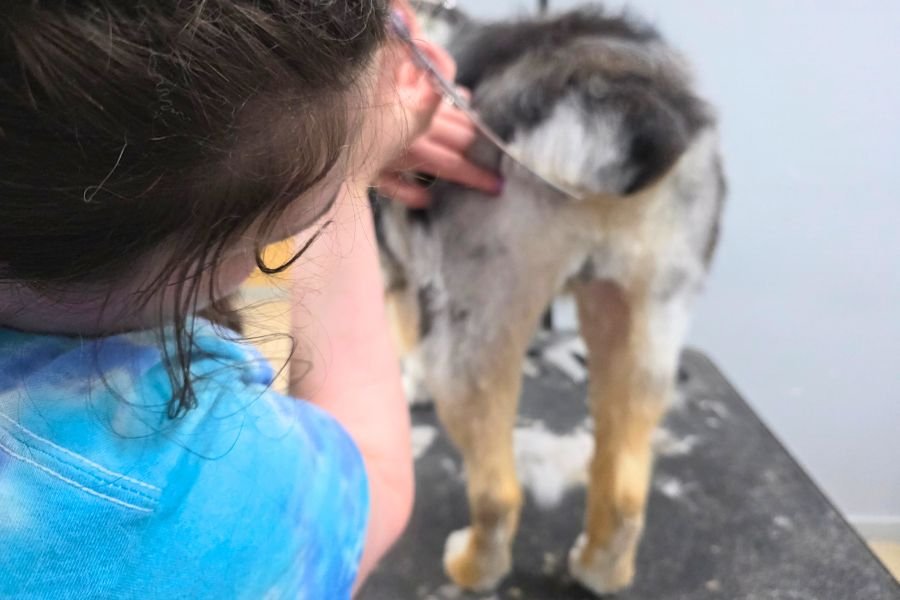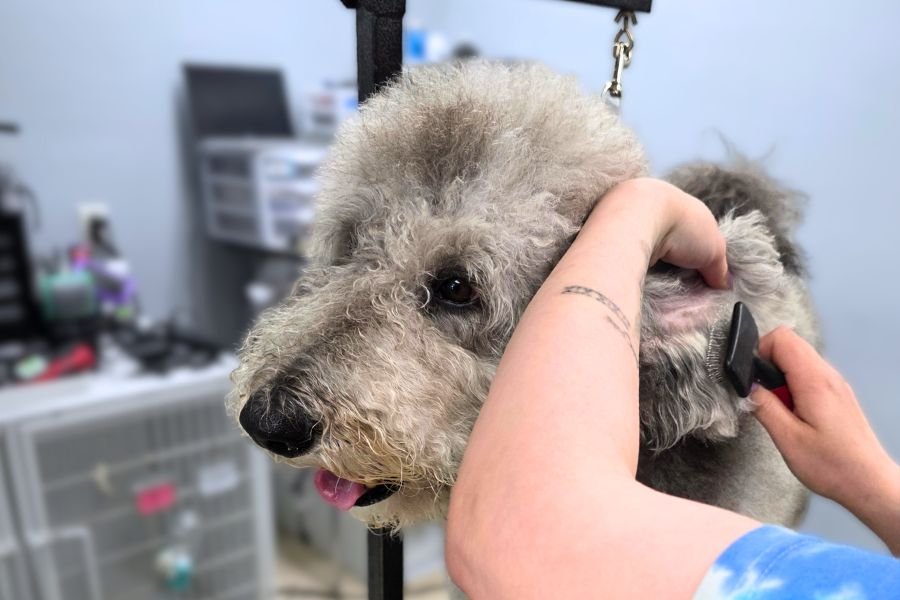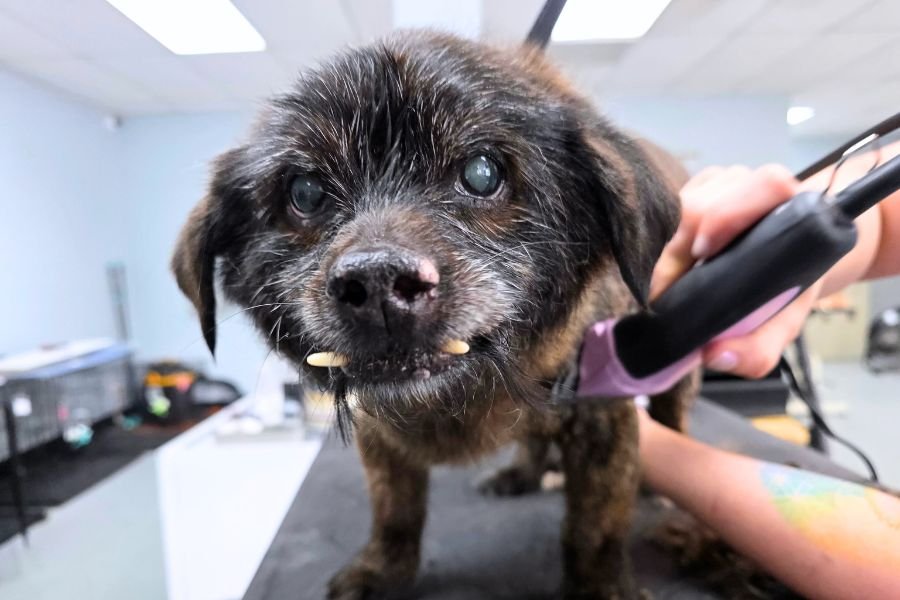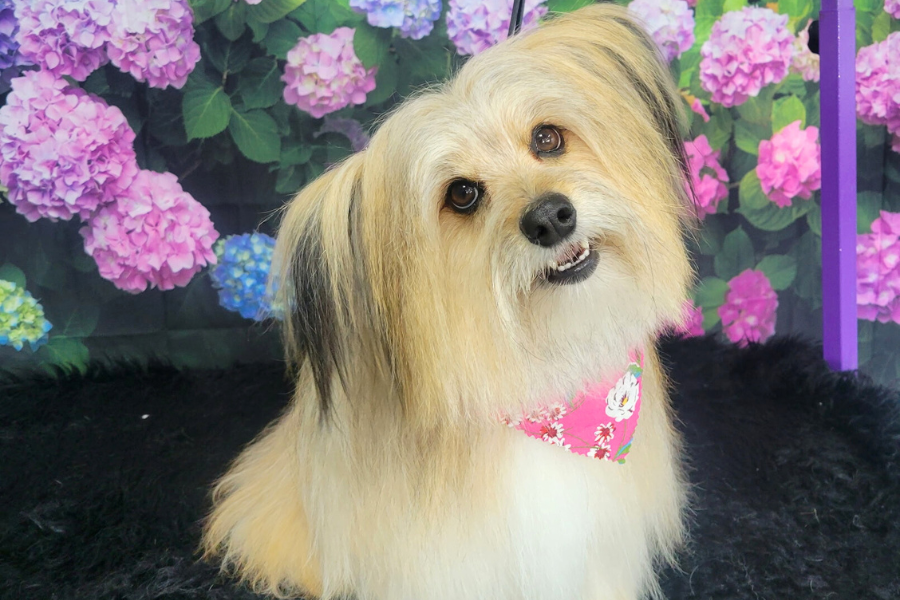How Often to Groom Your Dog
A Breakdown of Professional Dog Grooming Services By Professional Dog Groomers
By Hippie Hounds Grooming • June 5, 2025
How often your dog needs professional grooming depends on much more than just his breed or coat type. Even two dogs of the same breed and size can have two completely different grooming routines.
Getting your dog groomed is also much more than just a haircut; it’s an essential practice that (when performed by a trusted groomer) accounts for your dog’s holistic health.
At Hippie Hounds, every step of dog grooming is centered on providing the dogs in our care with individualized attention to their needs for optimal health. So, before we get into how often your dog should get groomed, let’s break down what happens at a professional grooming session.
Piper the Shepherd Mix, post pampering session at Hippie Hounds
Professional Dog Grooming Services
At Hippie Hounds, our professional, full-service dog grooming appointments always include bathing your dog, hand blowing-out their coat, fully combing and de-matting them, styling their coat (if desired/possible), maintaining their nails, checking their anal glands, and cleaning out their ears.
Each service has its respective impact on your dog’s overall health; therefore, the recommended lengths of time between visits to the groomer vary and depend on factors like your dog’s activity level, coat type, and amount of brushing/grooming done at home.
Let’s get down to the nitty gritty!

It’s important to understand your dog’s anatomy for the full picture of how often nail trimming and all dog grooming services are needed.
Nail Trimming
Your Dog’s Nail Trimming Needs
Of all services, nail trimming is the most frequent grooming need for ANY dog breed. Health and safety risks are involved with letting your dog’s nails get too long — the chance of injury to the nail itself, but also more serious and even life-threatening risks in the long term.
Dogs bear weight on their toes differently than humans, and having too long of nails can force too much pressure on their delicate joints. Over time, this can contribute to the development of arthritis or other painful joint conditions like hip or elbow dysplasia.
Without routine trimming, your dog’s nails are more likely to be torn off when they get stuck in things like blankets or long carpets. Nails can even break off from the impact of landing after a jump or launching off the couch.
Some breeds’ nails will even curl completely around and penetrate into the paw pad – something that is not just painful but may lead to infections that can be fatal without treatment.
Your Dog’s Nail Anatomy
Dogs have a cuticle on the inside of their nail called a “quick” that is covered by the hard outer shell. The quick is full of nerves and blood vessels, and cutting the nail too short will not only cause pain and bleeding but can negatively impact the sensitive bones in a dog’s foot.
The quick grows out after about 4 weeks, but CAN recede over time with diligent scheduling of nail trimming appointments. This is why we always recommend getting your dog’s nails trimmed by a professional groomer.
If you are confident that you can do nail trimming at home, please understand that although you might be able to get the length off the tip, a level of professional experience required to effectively get the nail short enough to start to recede without causing any pain to the dog.
Nail grinding in action, which is a gentler and more effective alternative to nail clipping
When to Get Your Dog’s Nails Trimmed
Instead of using nail trimmers to get the nail short enough for the quick to recede, we prefer to use a nail grinder at Hippie Hounds. It’s a gentler way to round down the hard claw part of the nail a little shorter and smoother.
We typically refer to this part of your dog’s grooming routine as “nail rehab” and recommend nail filing every 2 weeks for at least 3 months. Within this timeframe, we are able to see that most dogs’ nails have a drastic change in shape and size.
Bath, Brush & De-Shed
So, we see that nails need to be done a minimum of once a month for every breed. But what about baths?
Max the Dachshund all sudsy in the tub during his bath time at Hippie Hounds
How Often Your Dog Needs a Bath
All dogs have a keratinization cycle that averages around 21 days. It doesn’t matter whether you have a short-haired shedder like a pug, a medium dense coat like some Australian Shepherds, or a fully long/drop-coated breed like a Havanese – all dog breeds have the same need for once-a-month baths.
The key is understanding the differences in the role that sebum (natural oils) plays in the functioning of their coat. Your dog’s skin needs the right balance of natural oils to function properly.
Using proper conditioners to rehydrate the skin and coat after shampooing is CRITICAL to a dog’s full health and well-being.

Not using the right products for your dog can strip the oils from their coat, exposing nerves in the shallow parts of the skin, causing pain and irritation.
Using the Right Products for Your Dog’s Coat
Without a balanced level of natural oils in your dog’s coat, the risk of skin conditions increases. Yeast and bacteria can more easily infect the skin if natural oils have been stripped away. Matting can also occur more easily, and shedding typically increases on dry coats.
Many skin conditions can be easily treated with consistent (once-a-month) re-moisturizing baths rather than stripping away even more oils with harsh veterinary anti-fungal or anti-bacterial shampoos.
This is not to say don’t use these products; however, it is important to always follow ANY shampoo with a pet-safe conditioner.
Gracie the Pekingese Mix getting safely toweled off after her bath at Hippie Hounds
Safely Drying Your Dog After Bathtime
Drying your dog’s coat after a bath is also important, as water causes fur to wrap around itself and increase the chance of matting. Even a damp coat can lead to compacted undercoat or tangles and matting in longer coats.
While you want to make sure your dog’s coat is dried thoroughly, remember not to use any heat as this can raise your dog’s body temperature to dangerous levels and can also overdry your dog’s skin, making it itchy.
During our dog grooming process at Hippie Hounds, we only use a gentle, non-heated velocity dryer to blast the moisture from the coat and blow out any trapped “dead” fur we didn’t get out in the bathtub.
Anal Gland Expression for Dogs
And what about those anal gland things? We’re so glad you asked!
It’s generally accepted that dogs mark their territory by using a scent that comes from two sacs located just inside of their anus. When the stool is loose, there isn’t enough pressure on the anal glands to help naturally express them, and this can result in ruptured or infected anal glands.
Signs Your Dog Needs Anal Gland Expression
Most dogs can go their whole lives without these glands ever needing any attention, but many pups unfortunately need some assistance. A variety of factors can change the health of anal glands, but the most important is monitoring your dog’s stools for signs of looseness.
You’ll know your dog is experiencing anal gland discomfort if they are dragging their butt across the ground, chewing and licking at their rear end more often, or if you notice a fishy smell coming from the back end.
Anal Gland Expression by Dog Groomers
Professional dog groomers are experienced in expressing the anal glands by applying pressure on the outside of the anus, whereas in veterinary offices, staff members will apply direct pressure to the sacs on the inside.
The way dog groomers express anal glands doesn’t usually get 100% out, leading to a slow buildup over time that can cause issues if not paid attention to. It’s always a good idea to have your vet check your dog’s anal glands as well as have your groomer do the regular maintenance so problems can be detected early.
Trimming around a dog’s sanitary area during regular grooming helps maintain optimal hygiene.
How Often to Get Your Dog’s Anal Glands Checked
Although there is a lot of debate on how often anal glands should be expressed, we confidently recommend checking them at least once a month.
This professional dog grooming service is another testament to the benefits that routine grooming can have on your dog’s overall health. Abnormailities seen in regualr anal gland expression can be early indicators of serious problems. In our experience, we’ve even detected initial signs of cancer in the anus.

With regular attention paid to your dog by trusted and professional groomers, you have more than just your vet on your side to identify any areas of concern in early stages.
Ear Cleaning
How & When to Clean Your Dog’s Ears
While anal glands are sensitive and should only be handled by professionals, cleaning your dog’s ears is a routine habit that can greatly improve your pet’s well-being. Most dogs’ ears should be cleaned anywhere from once a week to every other week. If your dog deals with ear infections, they may need ear cleaning even more frequently.
There is a delicate bacterial balance inside your dog’s ears, and harsh products can disrupt the environment, leading to more ear infections. We recommend using a witch hazel-based ear cleaner on your dog.
What to Avoid When Cleaning Your Dog’s Ears
- Always AVOID anything that has alcohol or hydrogen peroxide as ingredients, as these are very stripping and drying.
- NEVER stick your finger deeper in your dog’s ear than you can see, and do not use any Q-Tips due to the risk of puncturing their eardrum if she shakes her head at the wrong time.
- Ear powder should NEVER be poured directly into the ear canal, as this will lead to a painful blockage of pressed ear powder that could lead to needing surgical intervention.
Merry the Doodle getting her ears gently brushed and cleaned at Hippie Hounds
When to Take Your Dog to a Professional
It’s a good idea to keep an eye on the volume of ear canal hair twice a month. Most breeds will not need any ear hair removal, so it is important to discuss this with your vet to understand your pet’s exact needs.
Some breeds will need forms of ear plucking if there is too much hair in the ear canal. We recommend leaving this for the vets to handle. Having a professional and thorough plucking by your vet helps to treat mats or infections that can occur due to overgrown hair.
Ear cleaning is always included in your dog’s grooming routine at Hippie Hounds. We only use the most gentle methods to maintain the hair in the ear canal as it grows out.

When made a consistent part of your dog’s grooming routine, ear cleaning helps decrease the buildup of debris and bacteria that lead to infections.
Dental Cleaning
Your Dog’s Dental Needs
Taking care of your dog’s dental health is important for not just their mouth but also their internal organs and longevity. Brushing our dogs’ teeth is something so simple that it can easily be overlooked — but teeth-brushing can have a major impact on the end of their life by adding healthy time or causing sharp declines.
Dog dental diseases have been linked to a decline in heart health, complications with diabetes issues, and several other organ problems. Once an infection enters their bloodstream, there is little that can be done to improve their quality of life.
Oliver the Terrier Mix, mid-pampering at Hippie Hounds
How Often to Brush Your Dog’s Teeth
Daily brushing with an enzymatic toothpaste is ideal and recommended; however, brushing even 3-4 times per week will help improve the general health of your dog.
Professional dental services or procedures are typically required anywhere from once to twice a year and should be regularly discussed at your dog’s vet checkups.
When your dog comes to Hippie Hounds for his pampering session, brushing his teeth is a $10 add-on service!
Haircuts
Now that we’ve discussed all the health care services involved in professional dog grooming and their recommended frequency, we’ve reached the final and most popular question: How often does my dog need a haircut?
Once again, the somewhat annoying answer is … it depends! What follows are our recommendations to consider.
Poppy the Eskiepoo looking beautiful, fresh, and clean after her haircut at Hippie Hounds
Your Dog’s Grooming Needs
For dogs that have hair that can get matted, we usually recommend a once-a-month full haircut with a partial groom in between. Dogs with longer coats who shed may only need feather trim haircuts for stylistic or easier maintenance purposes.
Your dog’s full-service haircut at Hippie Hounds includes all the bells and whistles — nail trimming, a re-moisturizing bath, full by-hand blow-dry, comb-out with mat removal, ear cleaning, anal gland check, and, of course, her haircut!
The partial groom allows us to give your dog a full comb-out and mat removal to stop bigger areas from getting matted, taking the pain of dematting out of your hands. We also clip her sanitary areas shorter for hygiene and remove fur from her feet, leading to better traction and comfort for walking. Last but not least, we’ll give your dog a quick face trim, leaving her fluffy and adorable every month.

If once-a-month full-service grooms are not in your budget or scheduling allowance, most breeds need full clipper cuts at least every 6 weeks before matting begins.
Maintaining Your Dog’s Coat at Home
Getting your dog groomed professionally does not take the responsibility out of your hands to keep up with combing at home. Even if you take your dog to the groomer once a month, if you are expecting a long haircut style, more brushing and proper combing down to the skin almost daily are needed to reduce painful tangles and matting.
Deshedding or combing out your dog regularly at home will allow his coat to properly function, keeping him cooler or warmer when needed and reducing the amount of hair that sheds off of him.
The Tail End
In conclusion, the not-so-clear answer to “How often should I groom my dog?” would be that most grooming needs occur on a monthly basis, and sometimes even more frequently.
In our opinion, the better question to ask yourself is, “How much time and energy am I willing to allocate to keeping my dog properly groomed?”
We hope this information is helpful and good to keep top of mind when choosing a dog breed that fits your lifestyle — and that grooming is an essential healthcare need for ALL dog breeds.


